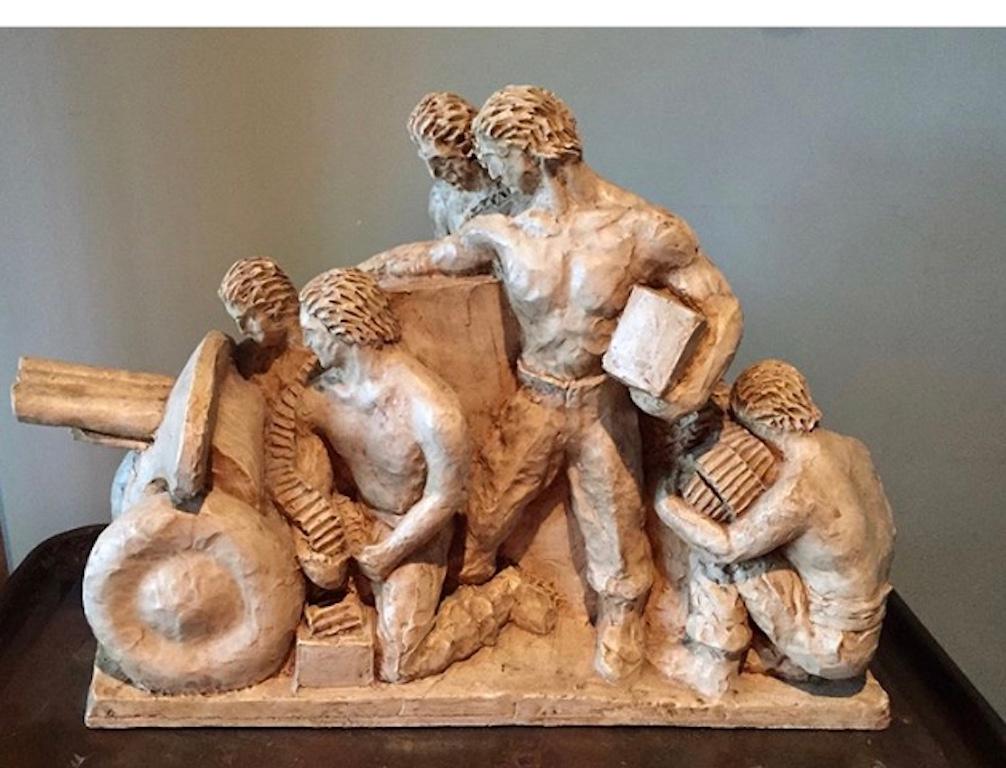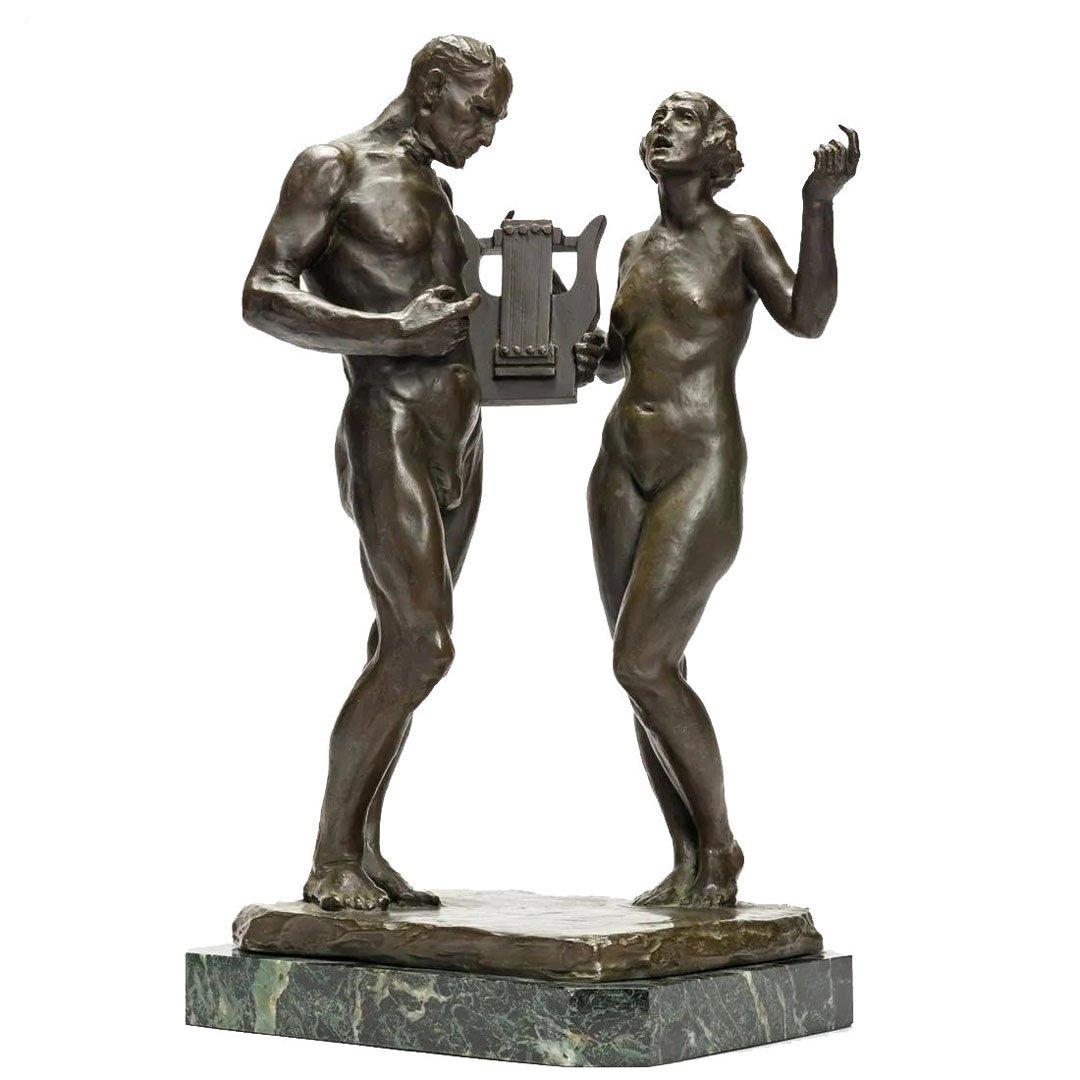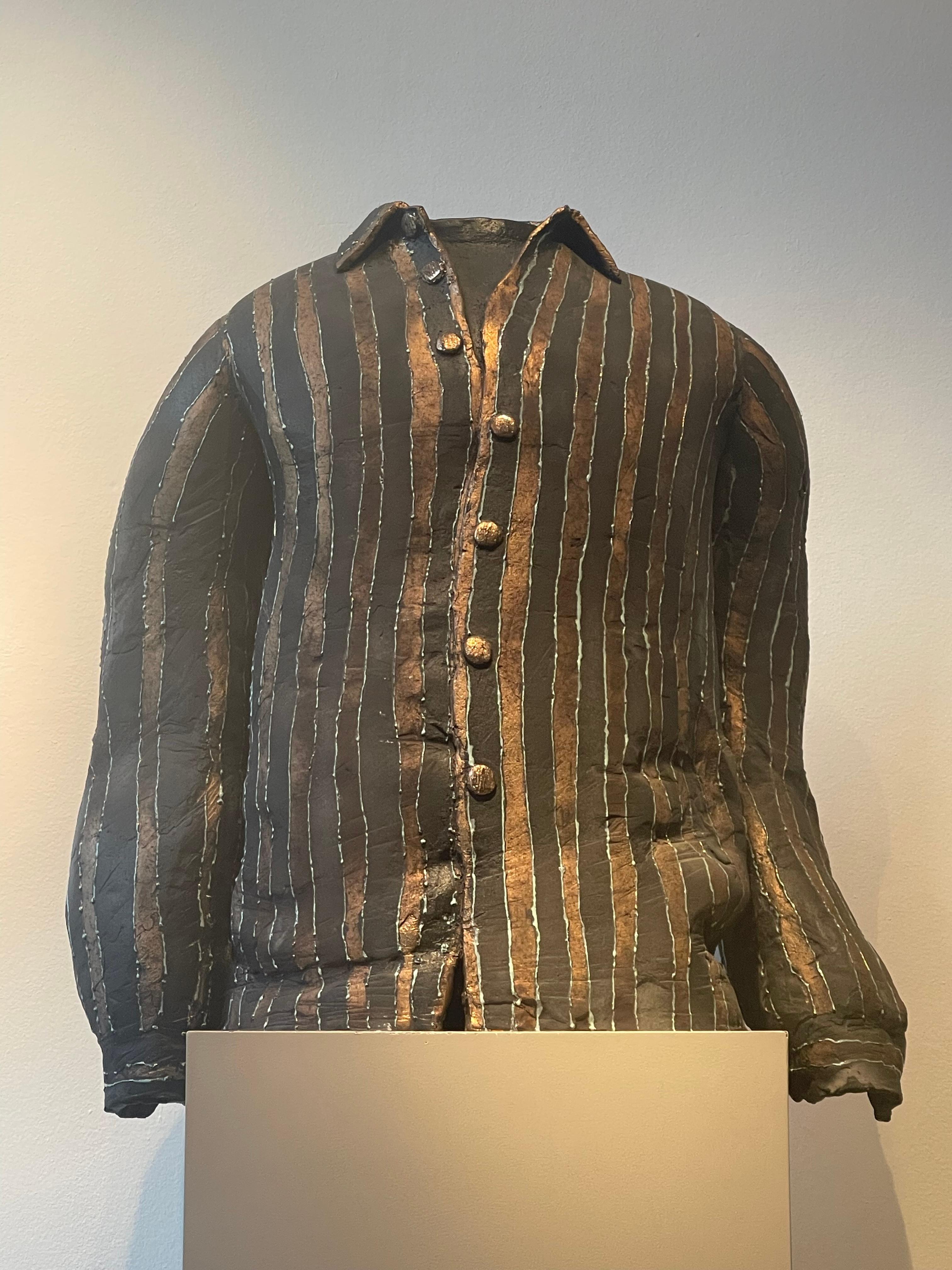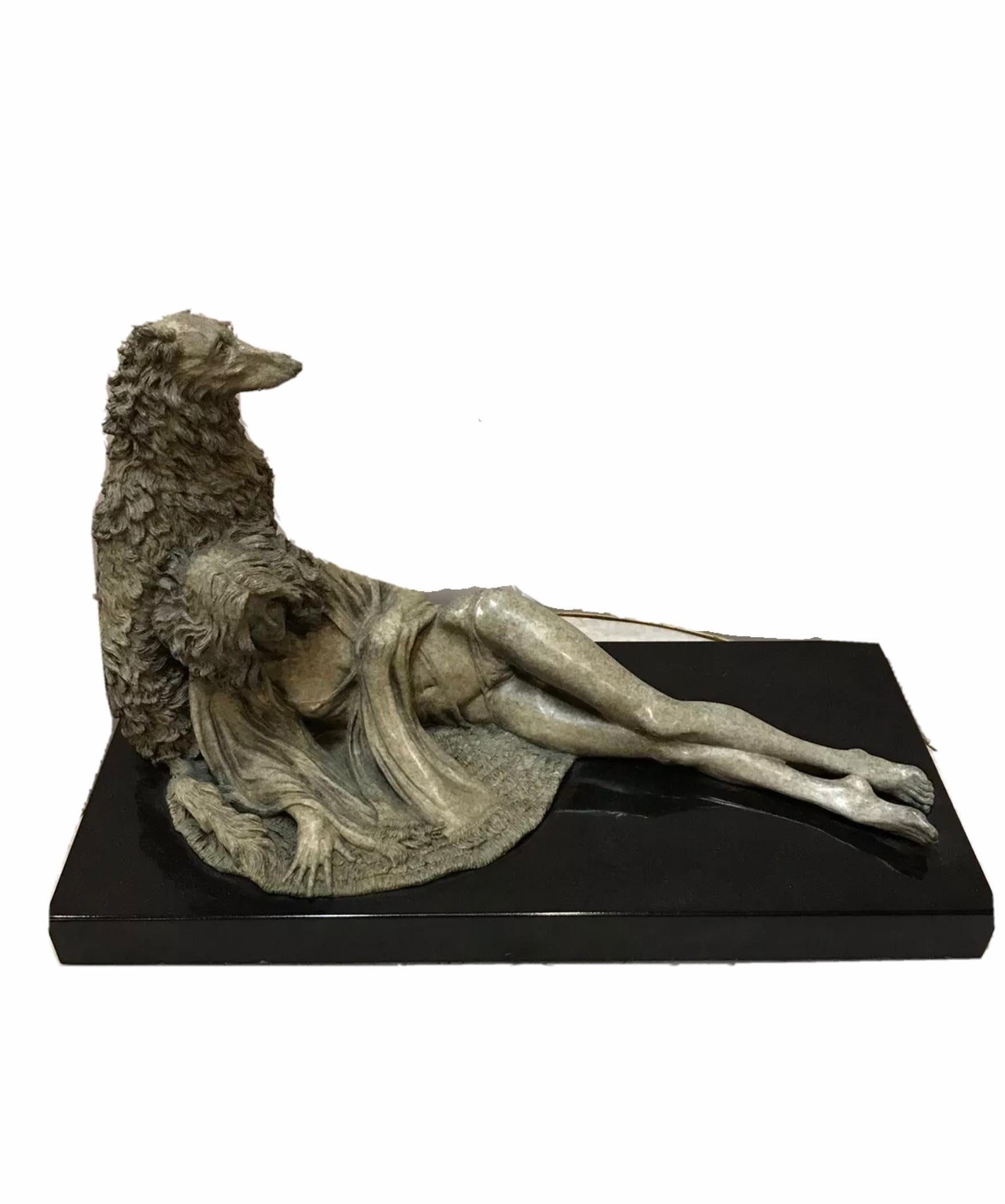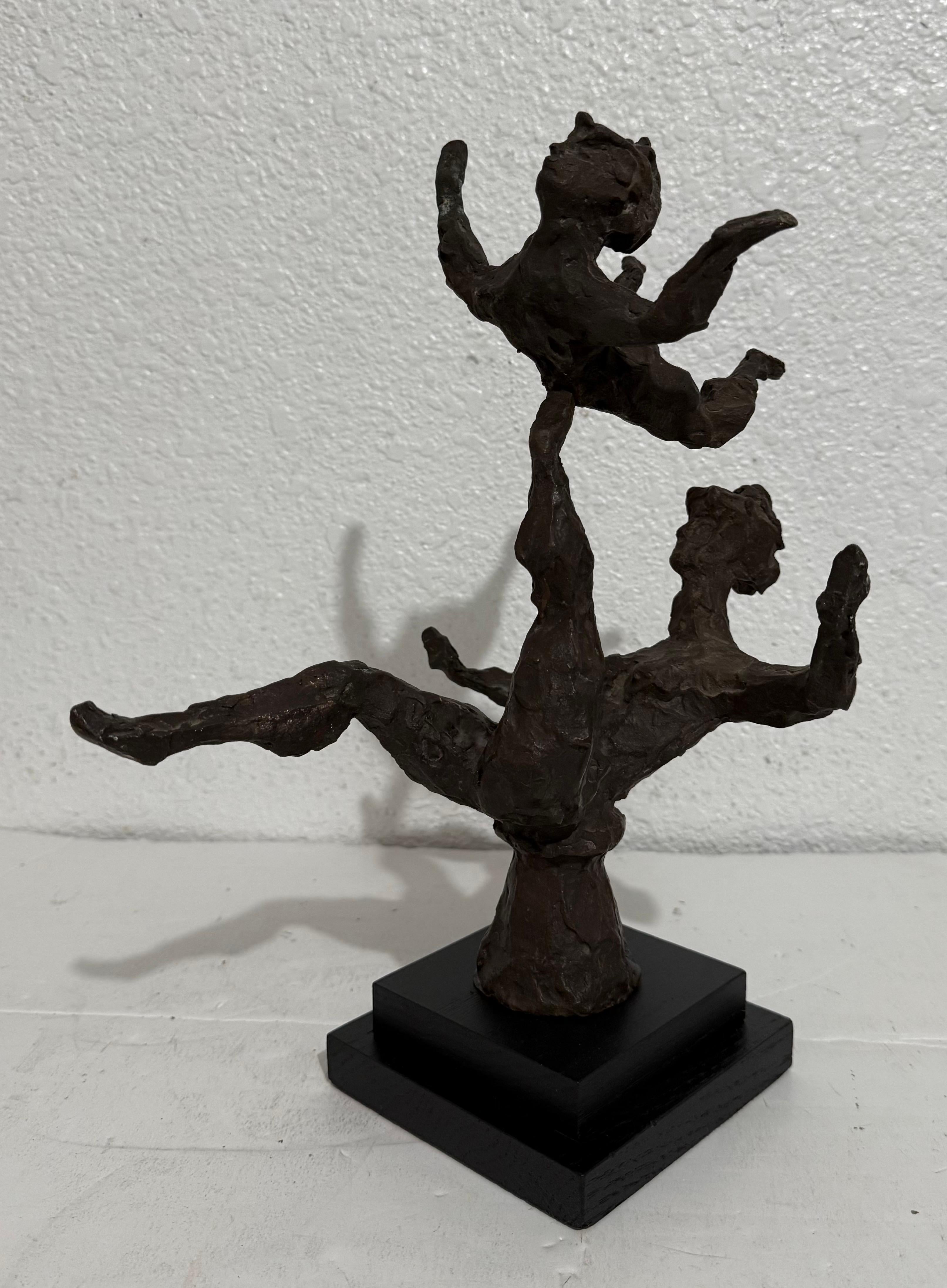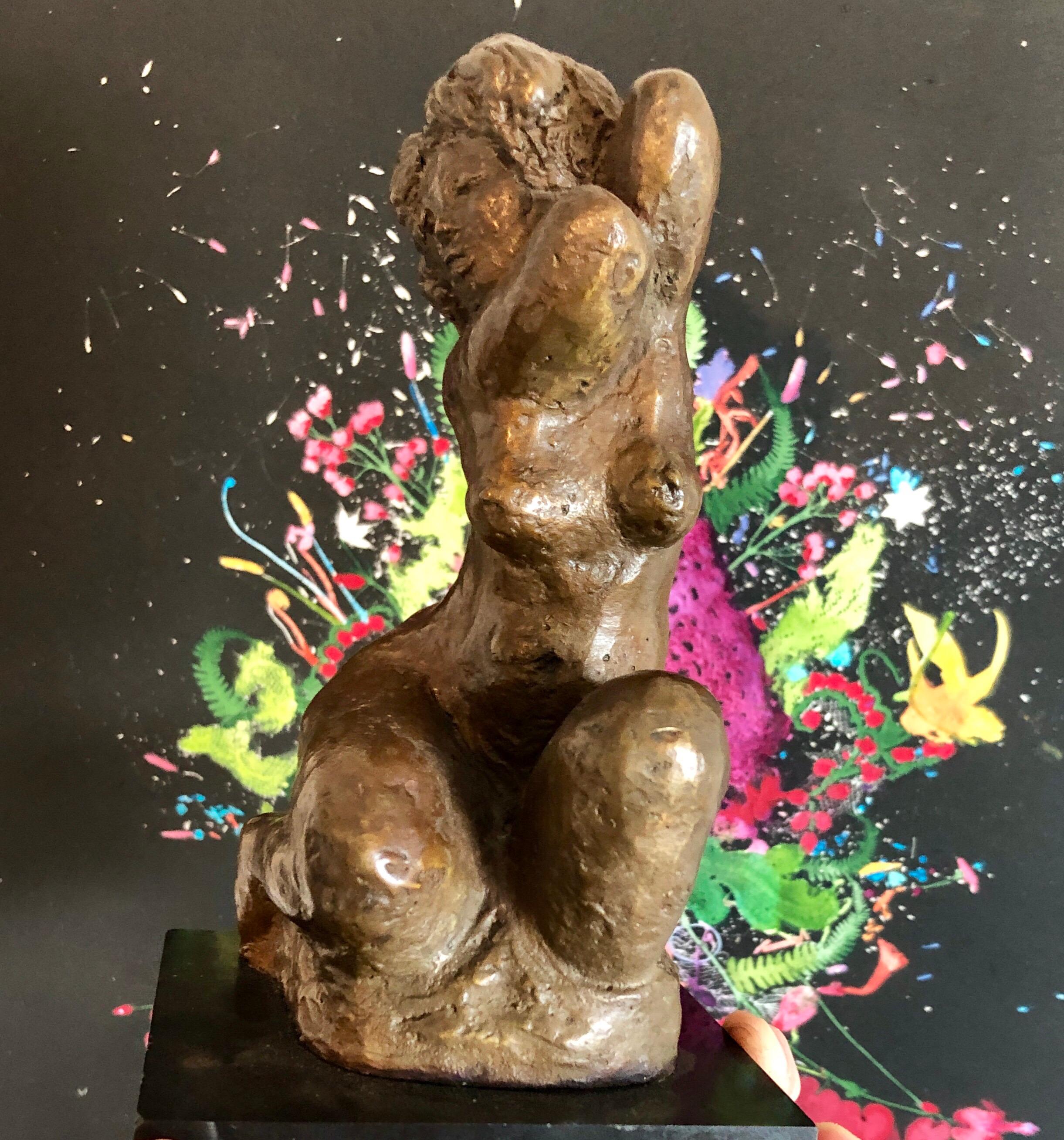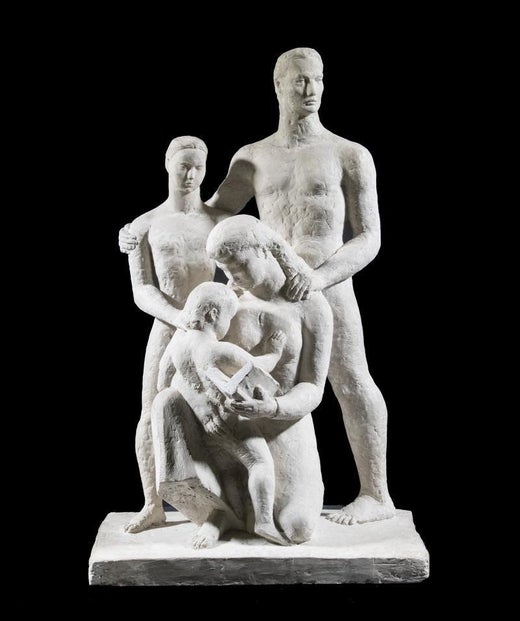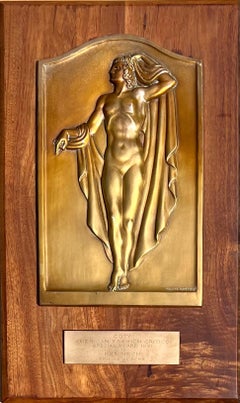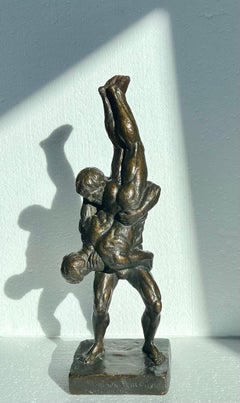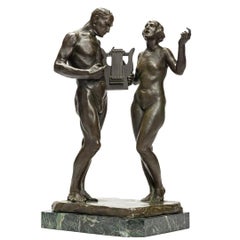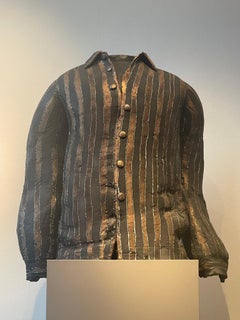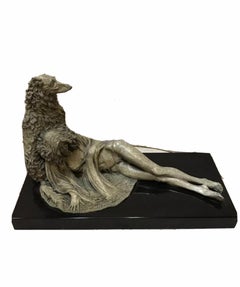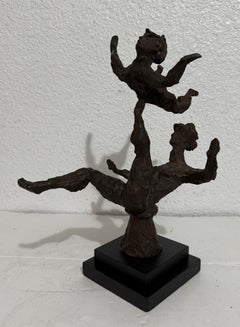Items Similar to "Pioneer Family" WPA American Modernism Plaster Maquette Realism 20th Century
Want more images or videos?
Request additional images or videos from the seller
1 of 6
William Zorach"Pioneer Family" WPA American Modernism Plaster Maquette Realism 20th Century1927
1927
About the Item
"Pioneer Family," 23 1/2 x 16 1/4 x 10 3/4 inPlaster. c. 1927. Unsigned. Realism
The Smithsonian has a cast of this sculpture in its collection. Pictured on the cover of “The Sculpture of William Zorach”
William Zorach (1887 – 1966) Born in 1887 in Lithuania, Zorach immigrated with his family to the United States when he was just four years old, settling in Cleveland, Ohio. Zorach displayed an exceptional artistic talent at a young age and, at the recommendation of his seventh-grade teacher, began studying lithography at night at the Cleveland School of Art. It was not long before he was apprenticing at a lithography company in Cleveland. It was there that he realized he wanted to become an artist - to escape the commercial end of the field in which he was suddenly immersed.
In 1907, Zorach saved enough money to move to New York and study art at the National Academy of Design, where he received several awards for his paintings and drawings. He continued his studies in Paris in 1910 at La Palette. This year abroad would turn out to be quite fruitful because in Paris he was greatly influenced by the Cubist and Fauvist movements and had several paintings exhibited at the Salon d'Automme. This influence and subsequent success fueled his career back in the states where he was honored with his first one-man exhibition. Due to this new-found stability, he married a young woman he met at school in Paris, and they moved to New York and set up a studio. Shortly after, their work was accepted into the famous 1913 Armory Show.
For the next nine years, Zorach continued to think of himself as a painter, although he had already begun to experiment in sculpting. He was experiencing modest success with his painting and was therefore reluctant to abandon it completely. However, he was impelled toward sculpting, and in 1922, he painted his last oil.
Zorach's involvement with sculpture began largely be accident. While he was working on a series of wood-block prints, Zorach suddenly became more interested in the butternut panel than the print and turned the panel into a carved relief. With no formal training as a sculptor, Zorach's first sculptures were of wood and his carving tools were primitive, such as a jack-knife. I n fact, his early works have a certain stylized look, suggesting the influence of various primitive arts such as African and American folk.
Zorach found his sculptural direction by instinct, but was not unaware of what other sculptors were doing, both here and abroad. He soon allied himself with a growing number of modern sculptors who believed in the esthetic necessity of carving their own designs directly in the block of stone or wood rather than modeling them in clay. From the beginning he found a deep satisfaction in the slow and patient process of freeing the image from its imprisoning block, watching the forms emerge and appear.
"The actual resistance of tough material is a wonderful guide," Zorach said in a lecture on direct sculpture in 1930. The sculptor "cannot make changes easily, there is no putting back tomorrow what was cut away today. His senses are constantly alert. If something goes wrong there is the struggle to right the rhythm. And slowly the vision grows as the work progresses." Zorach also found that the material itself had a constantly modifying effect on the artist's vision. The grain of the wood, the markings in the stone, the shape of the log or boulder all set limits and suggested possibilities. He was always sensitive to the characteristic qualities of his material and occasionally let them play a major role in determining his forms. In works such as these, the feel of the original material is preserved in the finished piece and is often heightened by leaving parts of the original surface untouched and other areas roughly marked by the sculptors tools.
In 1923 Zorach bought a farm in Maine, where he and his family would spend their summers. He continued to sculpt and was soon recognized as one of the country's premier artists, honored with multiple commissions throughout the country and exhibitions at the Art Institute of Chicago, the Dallas Museum of Fine Art, the McNay Art Institute, and the Whitney Museum of American Art, among others. Today his work can be found in such prestigious museums as the Metropolitan Museum of Art, the Museum of Modern Art, the Whitney Museum of American Art, the Art Institute of Chicago, the Boston Museum of Fine Art, the Los Angeles Museum of Art, the Brooklyn Museum and the Cleveland Museum of Art.
In all, Zorach's sculpture is not outwardly American. It deals with the universal themes of life. He ultimately played a major role in rescuing American sculpture from the neo-classical tendencies and illustrative modeling which dominated it at the turn of the century. He helped to develop an isolated avant-garde in this country due in part to his focus not only on universal themes but on the intrinsic beauty of his material, sensuous tactile values, subtlety of modeling and a variety of imagery.
- Creator:William Zorach (1887 - 1966, American)
- Creation Year:1927
- Dimensions:Height: 24 in (60.96 cm)Width: 17 in (43.18 cm)Depth: 11 in (27.94 cm)
- Medium:
- Movement & Style:
- Period:
- Condition:
- Gallery Location:New York, NY
- Reference Number:1stDibs: LU115629027912
William Zorach
Born in 1887, by 1930, he was one of America’s premier 20th century sculptors and was honored with multiple commissions and exhibitions including at the Art Institute of Chicago, the Dallas Museum of Fine Art, the Whitney Museum of American Art, and numerous others. He studied in New York City at the National Academy of Design and also in Paris under the mentoring of Jacques-Emile Blanche. It was in Paris in the first decade of the 20th century where Zorach’s path crossed with Marguerite, his soon to be wife. Both Marguerite and William were both represented in the landmark Armory Show of 1913. William continued to paint for the next two decades, but increasingly experimenting with sculpture. By the mid 20’s he was carving significant works in marble and stone. By the early 30’s, he abandoned painting entirely in favor of a new art form, sculpture. I t was in sculpture that Zorach found his true voice as an artist and achieved considerable success. “Sculpture, direct carving, was an expanding universe, a liberation and a natural form of expression to me.” Zorach stated. Museum Collections: Amon Carter Museum of American Art
Arizona State University Art Museum
Boca Raton Museum of Art
Butler Institute of American Art
Cleveland Artists Foundation
Colorado Springs Fine Arts Center
Cornish Colony Museum
Dallas Museum of Art
Delaware Art Museum
Edwin a Ulrich Museum of Art
Farnsworth Art Museum
Flint Institute of Arts
Frederick R Weisman Art Museum
Georgia Museum of Art
Herbert F Johnson Museum of Art
Jack S Blanton Museum of Art
LaSalle University Art Museum
Los Angeles County Museum of Art
Lowe Art Museum
Marion Koogler McNay Art Museum
Memorial Art Gallery
Metropolitan Museum of Art, NYC
Middlebury College Museum of Art
Minneapolis Institute of Arts
Mobile Museum of Art
Museum of Fine Art-Boston
Pennsylvania Academy of the Fine Arts
Portland Museum of Art
Smithsonian Museum of Art
The Brooklyn Museum of Art
The Canton Museum of Art
The Columbus Museum of Art-Ohio
The Columbus Museum-Georgia
The Cummer Museum Of Art & Gardens
The Currier Museum of Art
The Nelson-Atkins Museum of Art
The Newark Museum
The Phillips Collection
The Phillips Museum of Art
The University of Michigan Museum of Art
Whitney Museum of American Art
Worcester Art Museum
Yosemite Museum
About the Seller
5.0
Platinum Seller
Premium sellers with a 4.7+ rating and 24-hour response times
Established in 2008
1stDibs seller since 2019
190 sales on 1stDibs
Typical response time: <1 hour
- ShippingRetrieving quote...Shipping from: Pawling, NY
- Return Policy
Authenticity Guarantee
In the unlikely event there’s an issue with an item’s authenticity, contact us within 1 year for a full refund. DetailsMoney-Back Guarantee
If your item is not as described, is damaged in transit, or does not arrive, contact us within 7 days for a full refund. Details24-Hour Cancellation
You have a 24-hour grace period in which to reconsider your purchase, with no questions asked.Vetted Professional Sellers
Our world-class sellers must adhere to strict standards for service and quality, maintaining the integrity of our listings.Price-Match Guarantee
If you find that a seller listed the same item for a lower price elsewhere, we’ll match it.Trusted Global Delivery
Our best-in-class carrier network provides specialized shipping options worldwide, including custom delivery.More From This Seller
View All2 Sculptures: "The Power" & "The Glory" WPA Depression WWII era mid 20th century
By Agnes Yarnall
Located in New York, NY
2 Sculptures: "The Power" & "The Glory" WPA Depression WWII era mid 20th century by Agnes Yarnall circa 1940s.
Sculptor, painter, poet and artistic historian, Agnes Yarnall has, since the age of six been breathing life into her art.
Renowned as a sculptor, whose commissioned portrayals of contemporary celebrities are prized. She has sculpted Judith Anderson, Edna St. Vincent Millay, Carl Sandburg...
Category
1940s American Modern Figurative Sculptures
Materials
Plaster
1961 Coty Award Plaque Kenneth Hairdresser Jacqueline Onassis Bronze Fashion
Located in New York, NY
1961 Coty Award Plaque Kenneth Hairdresser Jacqueline Onassis Bronze Fashion
Bronze on wood. The wood plaque measures 12 3/4" by 20 3/4 inches. The bronze plaque itself is 13 3/4 x 8 3/4 inches and the the bronze inscription, which reads "COTY, American Fashion Critics Special Award 1961 to KENNETH of LILY DACHE...
Category
1960s American Modern Figurative Sculptures
Materials
Bronze
Breton Wrestlers Plaster Figurative Modern Male Sculpture Female Artist LGBT WPA
Located in New York, NY
Breton Wrestlers Plaster Figurative Modern Male Sculpture Female Artist LGBT WPA
Malvina Hoffman (American, 1885 - 1966)
"Breton Wrestlers"
20 inches high
Plaster
Signed and titled BRETON WRESTLERS, PARIS, 1929
Stamped "MPI on the back of the base, likely a museum reproduction of the bronze.
The Sculpture is recorded in the Smithsonian American Art Museum's Inventories of American Painting and Sculpture database under the Control Number: IAS 9E260042.
Artist's quote about the subject:
"The wrestlers were done from actual Breton athletes, at St. Guenole – the tip end of Finistere in Brittany, France. After I saw them on the beach there I persuaded them to come to Paris where I could finish the details of the three positions and have them authenticated. This form of wrestling, I am told, is no longer permitted, as there were too many serious accidents, and sometimes broken necks."
-M. Hoffman
April 27, 1962
Born in New York City, Malvina Hoffman was a portrait sculptor of pieces that expressed the fluid movement of dancers and lofty human values. She became especially noted for her hall-of-fame portraits including Paderewski, Pavlova, Wendell Wilkie and Katharine Cornell.
Many of her pieces she carved in stone, and some of them were enormous in scale including war monuments. Her masterpiece is considered to be The Races of Man, done in 1933, commissioned by the Marshall Field Museum of Natural History in Chicago. It had one-hundred five separate pieces, cast in bronze, depicting people from diverse cultures.
She grew up in an art-oriented environment in Manhattan where her father was a pianist and music filled the house. She attended the Brearley School and took private art classes, first studying painting with John White Alexander.
Changing to sculpture, she did her first work in 1909, a portrait bust of her father who died that year leaving the family in financial straits. However, his portrait was accepted for the National Academy of Design's annual exhibition and launched her career.
She studied with Herbert Adams...
Category
1920s American Realist Figurative Sculptures
Materials
Plaster
Reclining Man Ashcan Early 20th Century American Scene Social Realism Gay Nude
By Isidore Konti
Located in New York, NY
"Reclining Man" Ashcan Early 20th Century American Scene Social Realism Gay Nude
Isadore Konti (1862 - 1938)
"Reclining Man"
7 1/2 w x 4 1/2 d x 7 high inch...
Category
1910s American Realist Figurative Sculptures
Materials
Bronze
"La Comete" Iconic French Art Deco Silvered Bronze 1920s Female Nude
By Maurice Guiraud-Rivière
Located in New York, NY
"La Comete" Iconic French Art Deco Silvered Bronze 1920s Female Nude
Maurice Guirard-Riviere (1881 - 1947)
La Comete
Silvered bronze
23 inches wide x 19 3/4 inches high x 5 1/2 inc...
Category
1920s Art Deco Figurative Sculptures
Materials
Bronze
"Mercury" NYC 1931 Bronze 5th Ave Traffic Light Sculpture American Art Deco WPA
Located in New York, NY
"Mercury" NYC 1931 Bronze 5th Ave Traffic Light Sculpture American Art Deco WPA
In the late 1920s, Joseph Freedlander was asked by the City of New York ...
Category
1930s Art Deco Figurative Sculptures
Materials
Bronze
You May Also Like
Harmony, 20th century bronze & green marble base, nude man and woman with lyre
By Max Kalish
Located in Beachwood, OH
Max Kalish (American, 1891-1945)
Harmony, c. 1930
Bronze with green marble base
Incised signature on right upper side of base
14 x 9 x 5 inches, excluding base
17 x 10 x 8 inches, including base
Born in Poland March 1, 1891, figurative sculptor Max Kalish came to the United States in 1894, his family settling in Ohio. A talented youth, Kalish enrolled at the Cleveland Institute of Art as a fifteen-year-old, receiving a first-place award for modeling the figure during studies with Herman Matzen. Kalish went to New York City following graduation, studying with Isidore Konti...
Category
1930s American Modern Figurative Sculptures
Materials
Marble, Bronze
Large Ceramic Clay Sculpture Of Striped Shirt In Man Size On Piedestal
Located in Frederiksberg C, DK
Large sized sculpture of a standing shirt including large piedestal.
Category
Late 20th Century American Modern Figurative Sculptures
Materials
Ceramic, Clay
LADY AND SCOTTISH DOG
Located in Pasadena, CA
Magnificent beautiful masterpiece bronze sculpture of lady with the Scottish Deer Hunter dog bronze comes with green patina; 1/10
So beautiful and a lot...
Category
2010s American Modern Figurative Sculptures
Materials
Bronze
$5,200 Sale Price
20% Off
Chaim Gross Mid Century Mod Bronze Sculpture Balancing WPA Artist Mom and Child
By Chaim Gross
Located in Surfside, FL
Chaim Gross (American, 1904-1991)
Patinated cast bronze sculpture,
Balancing, Mother and child
signed and editioned 1/6
mounted on black marble plinth
14"h x 11.5"w x 8"d (height w...
Category
1960s American Modern Figurative Sculptures
Materials
Bronze
Bronze Female Nude Sculpture Modernist, WPA, New York Chelsea Hotel Artist
By Eugenie Gershoy
Located in Surfside, FL
Eugenie Gershoy (January 1, 1901 – May 8, 1986) was an American sculptor and watercolorist. Eugenie Gershoy was born in Krivoy Rog, Russia (Krivoi Rog, Ukraine) and emigrated to New York City in the United States as a child in 1903. Considered somewhat of a child prodigy, Gershoy was copying Old Master drawings at the age of 5. Her interest and talent in art was encouraged from a very young age. Aided by scholarships, she studied at the Art Students League under Alexander Stirling Calder, Leo Lentelli, Kenneth Hayes Miller, and Boardman Robinson. Around this time, she created a group of portrait figurines of her fellow artists, including Arnold Blanch, Lucile Blanch, Raphael Soyer, William Zorach, Concetta Scaravaglione, and Emil Ganso, which were exhibited as a group at the Whitney Museum of American Art. At age 17, she was awarded the Saint-Gaudens Medal for fine draughtsmanship. Early in her career she became an active member of the Woodstock art colony. In Woodstock she experimented by sculpting in the profusion of indigenous materials that she found. Working with fieldstone, oak and chestnut, Gershoy created works based on classic formulae. As she became more interested in the dynamism of everyday life, she found that these materials and her idiom were too restrictive. By the time Gershoy came to Woodstock in 1921 her own individual artistic style was already evident in her sculptures. Eugenie Gershoy worked in stone, bronze, terracotta, plaster and papier-mache. Gershoy’s sculptures were mainly figurative in nature and many of her artist peers such as Carl Walters, Raphael and Moses Soyer, William Zorach and Lucille Blanch, became her subjects. Eugenie Gershoy’s works on paper should not be overlooked. She was the winner of the Gaudens Medal for Fine Draughtsmanship at the tender age of 17. Gershoy married Jewish Romanian-born artist Harry Gottlieb. In the late 1920s and early 1930s, the pair kept a studio in Woodstock, New York. There, Gershoy was influenced by sculptor John Flanagan, who lived and worked nearby.
From 1936 to 1939, Gershoy worked for the WPA Federal Art Project. She collaborated with Max Spivak on murals for the children's recreation room of the Queens Borough Public Library in Astoria, New York. She developed a mixture of wheat paste, plaster, and egg tempera, which she used in polychrome papier-mâché sculptures; she was the only New York sculptor to work in polychrome at this time. She also designed cement and mosaic sculptures of animals and figures to be placed in New York City playgrounds. Alongside others employed by the FAP, she participated in a sit-down strike in Washington, DC, to advocate for better pay and improved working conditions for the projects' artists.
Gershoy's first solo exhibition was held at the Robinson Gallery in New York in 1940. She moved to San Francisco in 1942, and began teaching ceramics at the California School of Fine Arts in 1946. In 1950, she studied at the artists' colony at Yaddo.
Gershoy traveled extensively throughout her life. She visited England and France in the early 1930s, and worked in Paris in 1951. She traveled to Mexico and Guatemala in the late 1940s, and also toured Africa, India, and the Orient in 1955.
In 1977, Gershoy dedicated a sculpture to Audrey McMahon, who was actively involved in the creation of the Federal Art Project and served as its regional director in New York, in recognition of the work McMahon provided struggling artists in the 1930s.
Gershoy's work is in the collections of the Whitney Museum of American Art, the Metropolitan Museum of Art, and the Smithsonian American Art Museum. Her papers are held at Syracuse University Grant Arnold introduced her to lithography in 1930 and Gershoy depicted many scenes of Woodstock artists and their daily activities through this medium. From 1942 to 1966 Gershoy lived and painted in San Francisco where she taught at the San Francisco Art Institute. She traveled extensively, filling sketchbooks with scenes of Mexico, France, Spain, Africa and India. During her later years Eugenie Gershoy returned to New York City and concentrated on numerous well received exhibitions. Her last exhibition in at Sid Deutsch Gallery included many of the sculptures that were later exhibited in the Fletcher Gallery.
John Russell, former chief critic of fine arts for the New York Times, writes about the 1986 Sid Deutsch exhibition:
“As Eugenie Gershoy won the Saint-Gaudens Medal for fine draftsmanship as long ago as 1914 and since 1967 has had 15 papier-mache portrait figures suspended from the ceiling of the lobby of the Hotel Chelsea, she must be ranked as a veteran of the New York scene. Her present exhibition includes not only the high-spirited papier-mache sculptures for which she is best known but a group of small portraits of artists, mostly dating from the 30’s, that is strongly evocative.”
Eugenie Gershoy is an artist to take note of for several reasons. She was a woman who received great awards and recognition during a time when most female artists were struggling to hold their own against their male counterparts. As a young girl she won a scholarship to the Arts Student League where she met Hannah Small...
Category
Mid-20th Century American Modern Nude Sculptures
Materials
Bronze
Modern Bronze Relic Sculpture of figure with 3 legs: 'Rhoman Fertility Goddess'
By Joshua Goode
Located in New York, NY
Inspired by amateur archaeologists such as Heinrich Schliemann who discovered Troy and by past elaborate hoaxes like that of the Piltdown Man, Joshua travels the world performing sta...
Category
2010s American Modern Figurative Sculptures
Materials
Bronze
Recently Viewed
View AllRead More
Ludwig Bemelmans Captures the Thrilling Sight of Coney Island at Night
The ‘Madeline’ creator and Carlyle Hotel legend was in a New York state of mind in the 1940s when he produced this exuberant and rare oil painting.
Mid-Century Americans Didn’t Know Antonio Petruccelli’s Name, but They Sure Knew His Art
The New York artist created covers for the nation’s most illustrious magazines. Now, the originals are on display as fine art.
More Ways To Browse
Clay Family
Cast Plaster Sculpture
African American Antique
Plaster Woman
Log Sculpture
Plaster Relief Art
Antique Plaster Cast
Plaster Woman Sculpture
Neo Classical Sculpture
Antique Carving Tools
Antique Plaster Relief
Antique American Folk Art Sculpture
Antique Drawing Tools
Set 4 Plaster
Antique African Carvings
Modify Watches
Carved Boulder
Oil Free No Oil Stone
